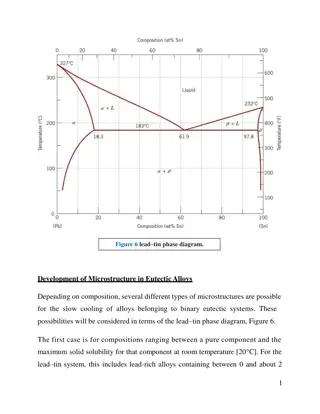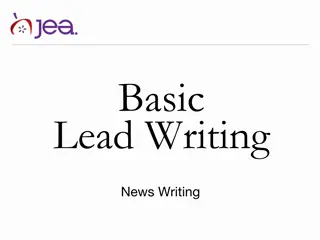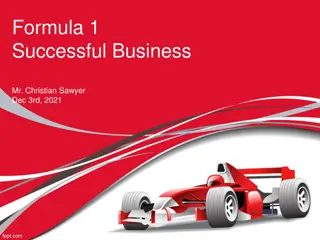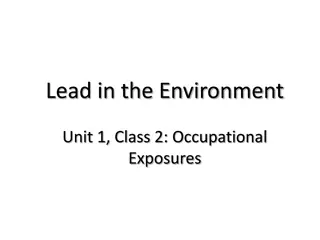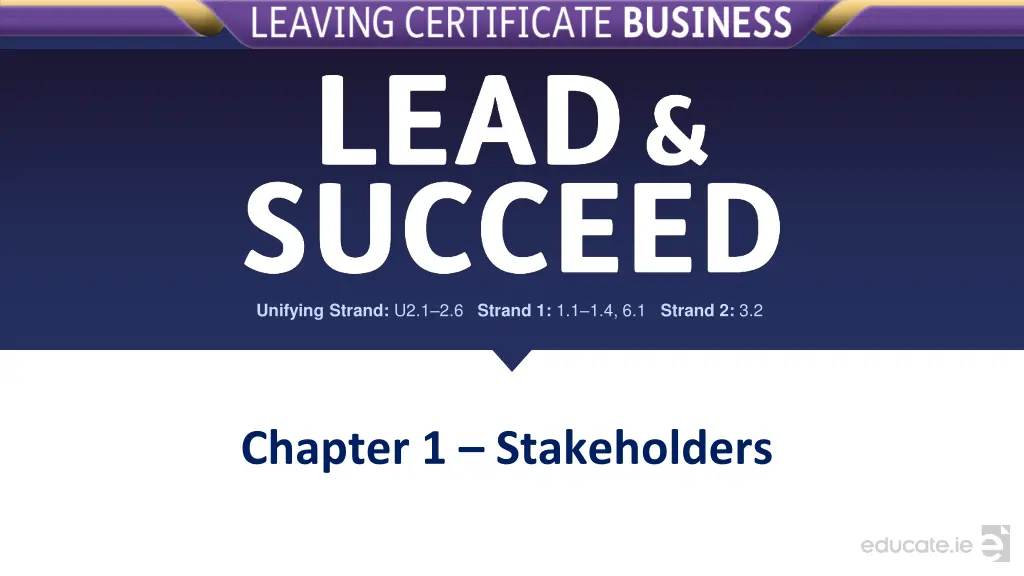
Understanding Stakeholders in Business
Learn about stakeholders in business, including who they are, their importance, and the key stakeholders in a company. Discover how decisions can impact stakeholders and why considering their interests is crucial for the success of an organization.
Download Presentation

Please find below an Image/Link to download the presentation.
The content on the website is provided AS IS for your information and personal use only. It may not be sold, licensed, or shared on other websites without obtaining consent from the author. If you encounter any issues during the download, it is possible that the publisher has removed the file from their server.
You are allowed to download the files provided on this website for personal or commercial use, subject to the condition that they are used lawfully. All files are the property of their respective owners.
The content on the website is provided AS IS for your information and personal use only. It may not be sold, licensed, or shared on other websites without obtaining consent from the author.
E N D
Presentation Transcript
CHAPTER 1 STAKEHOLDERS Unifying Strand: U2.1 2.6 Strand 1: 1.1 1.4, 6.1 Strand 2: 3.2 Chapter 1 Stakeholders
CHAPTER 1 STAKEHOLDERS 1.1 Introduction to Stakeholders
CHAPTER 1 STAKEHOLDERS Who Are Stakeholders? A stakeholder is an individual or a group that has an interest in an organisation and can either affect or be affected by that organisation. Every organisation, irrespective of its size, nature, structure and purpose, has stakeholders. Stakeholders can be either internal or external. Internal stakeholders: individuals and parties within the organisation. External stakeholders: do not work within a business, but are affected by its activities.
CHAPTER 1 STAKEHOLDERS Who Are Stakeholders? All decisions made by a business will impact on one or more of its stakeholders. Ignoring this impact may result in negative consequences for the organisation. For example, employees may be unhappy about a change in work practices that are being considered to reduce costs in a business. In that case, it may be detrimental to enforce these changes without considering staff views if it will result in: a demotivated workforce, which affects production levels and quality of work high staff turnover.
CHAPTER 1 STAKEHOLDERS Key Stakeholders in Business Entrepreneurs use their initiative to spot a gap in the market and take the personal and financial risk of setting up a business with the aim of making a profit. Owners are individuals or entities that hold legal ownership of a business. Owners can be entrepreneurs or shareholders, depending on the organisation. Employers hire employees to complete work in return for a wage or salary. When entrepreneurs recruit employees to work in the business, they become employers.
CHAPTER 1 STAKEHOLDERS Key Stakeholders in Business Employees work in a business in return for a wage or salary. Employees include managers people responsible for controlling and running an organisation, a system or a group of staff. A board of directors is the governing body of a company, consisting of the most senior managers. Its role is to set strategy, oversee management, and protect the interests of shareholders. Directors are appointed by the company shareholders at the annual general meeting (AGM). They appoint the managing director (MD) the most senior manager.
CHAPTER 1 STAKEHOLDERS Key Stakeholders in Business Investors provide capital (finance) for a business. Investors can be internal or external stakeholders. Shareholders (internal): invest money in return for a dividend (a percentage of the profit). Banks (external): provide loans that must be repaid with interest over an agreed time frame. State agencies (external): offer grants. No return is expected, but certain requirements must be met, e.g. a grant must be used for a specific purpose. Suppliers provide the raw materials required by a business.
CHAPTER 1 STAKEHOLDERS Key Stakeholders in Business Producers/manufacturers turn raw materials into finished products to sell to consumers. Service providers are businesses that supply services (banking, insurance, accountancy, etc.) required by the business. Consumers are people who buy or use goods and services for personal use, rather than for business purposes.
CHAPTER 1 STAKEHOLDERS Key Stakeholders in Business A local community is made up of the people who live in the area where a business is situated. They are concerned with the business s impact on the local environment, and how it can create local jobs and increase prosperity in the area. The local community expects the business to act ethically and to conduct its business in a sustainable manner. A government is made up of the elected representatives and administrative bodies responsible for governing. In Ireland, this includes the national government and local authorities. They set rules and regulations on how a business must operate. They collect taxes from the company, its employees and any other spending by the company.
CHAPTER 1 STAKEHOLDERS Key Stakeholders in Business Trade associations represent businesses involved in similar types of activities. Interest/pressure groups are organisations that represent people with a common interest. Lobbying is the practice of influencing government decisions by communicating with decision makers or gaining media attention for a certain viewpoint.
CHAPTER 1 STAKEHOLDERS Objectives and Impacts of Stakeholders Employees and managers Objectives Job security. Adequate remuneration. Good working conditions. Impacts Productivity and innovation (intrapreneurship). Overall organisation culture. Brand ambassadors.
CHAPTER 1 STAKEHOLDERS Objectives and Impacts of Stakeholders Suppliers, producers, manufacturers and service providers Objectives Fair procurement processes and negotiations. To be paid in full within credit terms. For all contracts to be honoured. Long-term partnership and loyalty. Impacts Steady supply of raw materials or services essential for production. Product quality, cost and delivery timelines. Strong supplier relationships.
CHAPTER 1 STAKEHOLDERS Objectives and Impacts of Stakeholders Consumers Objectives Good-quality and safe products. Reasonably priced products. Goods available in a timely manner. Good aftersales service. Truthful and accurate advertisements. Impacts Provide sales revenue and sustain the business. Valuable feedback and insights for product/service improvement. Brand reputation.
CHAPTER 1 STAKEHOLDERS Objectives and Impacts of Stakeholders Local community Objectives Employment opportunities. Support local suppliers. Ethical and responsible business practices. Contribution to local economy. Community engagement and support. Environmental stewardship. Impacts Pool of potential customers and workforce. Business reputation. An environment conducive to business growth and sustainability.
CHAPTER 1 STAKEHOLDERS Objectives and Impacts of Stakeholders Government Objectives Direct and indirect employment. Adhere to local, national and EU legislation. Taxes to be paid on time and in full. Co-operation with government offices. Community engagement and support. For grant conditions to be met. Impacts Regulations and laws that business must comply with. Provide infrastructure and service that support business operations. Economic conditions, trade policies and market stability.
CHAPTER 1 STAKEHOLDERS Objectives and Impacts of Stakeholders Trade associations/Interest groups Objectives Influence decisions/policies in favour of its members. Impacts Lobbying, negotiations, legal action or boycotting.
CHAPTER 1 STAKEHOLDERS 1.2 Stakeholder Interdependencies and Relationships
CHAPTER 1 STAKEHOLDERS Stakeholder Interdependencies In business, stakeholder interdependencies refer to the interconnected relationships among various groups such as investors, employees, customers, suppliers and the community. Each group s actions can impact others, influencing the company s operations, reputation and overall success. Managing these relationships effectively is essential for fostering co-operation, achieving goals, and maintaining trust and support from all stakeholders involved. For example: Employers need employees to work hard to make the business succeed, and employees need employers to provide them with good wages and working conditions. Consumers need businesses to provide them with goods and services, and businesses need consumers to buy their product.
CHAPTER 1 STAKEHOLDERS Types of Stakeholder Relationships Competitive relationship: each party works towards a separate goal. It is a win-lose approach, where only one party in the relationship wins. Co-operative relationship: both parties work towards a common goal. It is a win-win approach, where both parties work in partnership and not against each other. Dynamic relationship: a relationship that is constantly changing. Sometimes they help each other, i.e. the relationship is co-operative. At other times, it is competitive and may cause conflict. Dependent relationship: when both parties are reliant on each other to achieve their individual goals.
CHAPTER 1 STAKEHOLDERS Examples of competitive and co-operative stakeholder relationships Entrepreneur and investor Co-operative relationship The entrepreneur wants to expand the business, so they provide the investor with accurate and clear information (e.g. reports, business plans and cash-flow forecasts) and financial accounts that present a true and fair view. In return, the investor provides additional capital for expansion. The investor wins as they get accurate information to make informed decisions. The entrepreneur wins as they get additional finance for expansion. Competitive relationship The entrepreneur wants to expand the business, so they reinvest all the profits into the business and pay the shareholders little or no dividends. The entrepreneur wins as they get the money for expansion. The investor loses in the short term, as they get little or no dividend as a shareholder.
CHAPTER 1 STAKEHOLDERS Examples of competitive and co-operative stakeholder relationships Consumer and producer Co-operative relationship The consumer provides detailed feedback as part of the producer s market research queries. The producer wins as they get good-quality information on their target market. The consumer wins as the products are developed based on their needs and wants. Competitive relationship The producer changes the raw materials used in order to save money. This results in an inferior product. The producer wins (in the short term) as they reduce the cost and increase profit margin. The consumer loses as they receive a product of inferior quality. However, the producer could lose in the long term if the unhappy consumer decides to buy from a competitor.
CHAPTER 1 STAKEHOLDERS Examples of competitive and co-operative stakeholder relationships Employer and employees Co-operative relationship The employer offers flexitime to the employees. The employees win as they have an improved work-life balance. The employer wins as employees have good morale and are more productive. Competitive relationship The business wants to increase production, but employees engage in an official strike to protest pay. The employees win when they get a pay rise. The employer loses due to negative publicity and loss of sales.
CHAPTER 1 STAKEHOLDERS Needs and Wants of Stakeholders at Different Stages of Business Development Start-up stage Establishing the business, securing financing, creating brand or product awareness. Entrepreneurs: need capital, business plan, market research; want growth potential, support and advice. Employees: need clear roles, fair compensation; want career growth. Investors: need potential for return on investment, strong business plan; want high returns. Consumers: need quality product/service, innovation; want low prices.
CHAPTER 1 STAKEHOLDERS Needs and Wants of Stakeholders at Different Stages of Business Development Growth stage Scaling operations/market, increasing customer base. Entrepreneurs: need skilled workforce, finance; want market expansion, profitability, support and advice. Employees: need skill development, job security; want promotions, salary/wage increases, bonuses. Investors: need continued return on investment, information; want increased dividends. Consumers: need consistent quality, customer support; want new features.
CHAPTER 1 STAKEHOLDERS Needs and Wants of Stakeholders at Different Stages of Business Development Mature stage Maintaining stability, optimising operations and maximising profits. Entrepreneurs: need operational efficiency, cost control; want market dominance, sustained revenue. Employees: need fair compensation; want job satisfaction, promotions. Investors: need stable returns, transparency; want high dividends. Consumers: need reliable service; want loyalty rewards.
CHAPTER 1 STAKEHOLDERS Needs and Wants of Stakeholders at Different Stages of Business Development Renewal/Exit stage Revitalising the business to stay relevant, or exiting the business through a sale or a merger. Entrepreneurs: need succession planning, exit strategy; want legacy preservation. Employees: need clarity on future; want retention packages, new opportunities. Investors: need clarity on returns, exit options; want optimal exit valuation, smooth transition. Consumers: need service continuity, communication; want reassurance.
CHAPTER 1 STAKEHOLDERS How Changing Objectives Affect Stakeholders Changing business objectives can have significant implications for stakeholders. For example, it is essential for companies to consider the potential impacts and risks associated with expansion and to implement strategies to mitigate negative consequences. This may involve detailed planning, effective communication and a commitment to responsible business practices throughout the expansion process.
CHAPTER 1 STAKEHOLDERS How Changing Objectives Affect Stakeholders The decision to expand operations can have positive and negative impacts on different stakeholders in a business. Stakeholders Increased sales revenue can lead to increased profits for the business. Share value increases. Potential for higher dividend payouts in the future. x Increased financial risks, as expansion costs money.
CHAPTER 1 STAKEHOLDERS How Changing Objectives Affect Stakeholders Employees Career advancement opportunities. Improved job security. Increased opportunities for training. x If the expansion includes rationalisation, it could lead to: redundancies decreased staff morale change in job roles.
CHAPTER 1 STAKEHOLDERS How Changing Objectives Affect Stakeholders Consumers Increased availability of goods/services. Increased product portfolio and choice. Reduction in price due to the business benefitting from economies of scale. x Issues with quality control. Local community Improves the local economy due to job creation. x Environmental concerns of the expansion.
CHAPTER 1 STAKEHOLDERS Stakeholder Conflict Stakeholder conflict refers to a situation in which the interests or goals of different stakeholders in an organisation conflict with one another. For example, when a business moves production overseas, it may reduce wage bills, lower costs and increase profits, benefitting owners. However, this move may lead to conflicts with existing employees, as some may lose their jobs or have to relocate.
CHAPTER 1 STAKEHOLDERS Stakeholder Conflict The decision to grant a 10% pay rise to employees will have different consequences on different stakeholders in a business. Shareholders x Increased costs. x Reduced profits. x Possible reduction in dividends.
CHAPTER 1 STAKEHOLDERS Stakeholder Conflict Employees Higher staff morale. Higher standard of living. x Might cause business to look at cost-reducing measures, such as: reduced labour hours automation redundancies. Managers Higher standard of living if given pay rise. x Possible demotivation if not given pay rise.
CHAPTER 1 STAKEHOLDERS Stakeholder Conflict Consumers Better-quality customer service, as staff have good morale. x Possible price increases to recoup the increase in costs. x Possible reduction in product quality, as the business may change suppliers or reduce the quality of raw materials to recoup the cost increase. Suppliers x Pressure to renegotiate prices. x Business may change suppliers to avail of those who offer lower prices.
CHAPTER 1 STAKEHOLDERS Stakeholder Conflict Local economy Boost to the local economy from increased spending. Trade unions Validation of their efforts in securing raises for members. Government Increased tax revenue in the form of PAYE (pay as you earn) income tax when employees receive higher incomes. x Potential decrease in tax revenue if business profits fall.
CHAPTER 1 STAKEHOLDERS Avoiding stakeholder conflict Effectively managing stakeholder relationships is crucial for preventing conflict. The following strategies can help businesses to avoid potential issues: Open communication: ensures stakeholders are informed and aligned with business decisions. Stakeholder engagement: involving stakeholders in decision-making helps to manage expectations and build support. Compromise and balance: balancing the needs of different stakeholders through compromise is key. Social responsibility and ethics: adopting ethical practices and demonstrating social responsibility builds trust. Stakeholder mapping: prioritising engagement strategies and resolving potential issues before they arise.
CHAPTER 1 STAKEHOLDERS Resolving stakeholder conflict It is best to minimise conflict between stakeholders. When conflict does occur, it is important to manage it effectively to avoid negatively impacting the business s reputation. There are two approaches to resolving conflict. 1. Non-legislative approach: stakeholders try to solve the conflict by themselves or with the help of others, without the use of legislation or legal agencies. 2. Legislative approach: stakeholders use legislation or legal agencies to resolve the conflict.
CHAPTER 1 STAKEHOLDERS 1.3 Contract Law
CHAPTER 1 STAKEHOLDERS Stakeholders use contracts to legally establish deals with each other. A contract is a legally binding agreement between two or more parties, for example, a contract for the sale of a property.
CHAPTER 1 STAKEHOLDERS Elements of a Contract For a contract to be valid, all of the important elements must be fulfilled. Agreement Agreement (as an element of a contract) is when two or more parties agree to the terms of a contract. There are two parts to agreement. 1. Offer 2. Acceptance
CHAPTER 1 STAKEHOLDERS Elements of a Contract 1. Offer An offer is a voluntary promise with conditions made by one party (offeror) to another (offeree). An offer can be made verbally, in writing, or can be implied by conduct. An offer can be terminated by: being revoked before the offeree has accepted being rejected by the offeree the death of one of the parties not being accepted within a certain time frame.
CHAPTER 1 STAKEHOLDERS Elements of a Contract A counter-offer is when someone responds to an initial offer with different terms. A counter-offer is considered an automatic rejection of the first offer. When a retailer advertises a product or service for sale, the consumer is given an invitation to treat. This means the consumer is invited to make an offer to buy the product, and the offer can either be accepted or rejected. This is to protect the retailer if a price is incorrectly displayed or quoted. 2. Acceptance Acceptance is when the offeree agrees to all the terms of the offer without any changes or conditions. Acceptance can be oral, written or implied by conduct.
CHAPTER 1 STAKEHOLDERS Elements of a Contract Consideration Consideration means that each party in the contract must give something of value to the other, usually a monetary payment. Capacity to contract Capacity to contract means that each party has the legal right to enter the contract. The following people generally do not have the capacity to contract: minors (people under 18 years of age), except for necessities, e.g. food and clothing people of unsound mind or medically diagnosed as mentally incapacitated people temporarily incapacitated by alcohol or other drugs people who are bankrupt diplomats company directors acting ultra vires (beyond their legal authority).
CHAPTER 1 STAKEHOLDERS Elements of a Contract Consent to contract Consent to contract means that the parties entering the contract must do so of their own free will, without undue influence. A contract is not considered legally binding if: a person is pressured against their will a person is given misleading or false facts about the contract a genuine mistake can be shown to have occurred, e.g. accidentally entering a contract. Intention to contract Intention to contract means that both parties must be aware that they are entering into a legally binding agreement which is enforceable by the courts. Two important assumptions are made: business agreements are always intended to be legally binding with all domestic and social arrangements, there is no intention to create a legally binding contract.
CHAPTER 1 STAKEHOLDERS Elements of a Contract Legality of form Legality of form means certain contracts must be drawn up in a particular manner to be considered legal. For example, contracts for property sales, hire purchase agreements and insurance policies must be in writing to be valid. Legality of purpose Legality of purpose means that in order for a contract to be valid, it must be for a legal purpose and in full compliance with all laws.






